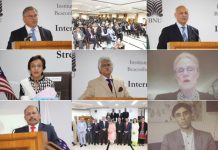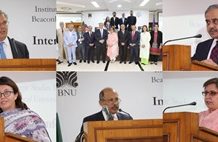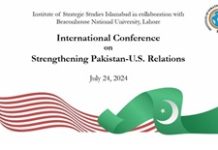Japanese Vice Minister for Foreign Affairs, Minoru Kiuchi, visited Pakistan on 11-12 September. He met with Advisor to the Prime Minister on National Security and Foreign Affairs Sartaj Aziz to discuss Japanese investment in Pakistan’s emerging energy infrastructure projects and their views on the future of Afghanistan. Aziz welcomed Japanese investments particularly in overcoming energy shortage in Pakistan and infrastructure development.
He appreciated Japan’s ongoing assistance in various social, educational, and health projects. Japan Foreign Direct Investment (FDI) has been US$ 22.8 million in 2011-12 by making its share to 2.8 percent of Pakistan’s total FDI that year. Japan ranked as the tenth largest investor in Pakistan. In the last 12 years, it was in 2006-7 that Japanese FDI was increased to US$ 64.4 million. Bilateral trade recorded US$ 2.2 billion in 2011, largely tilting the balance of trade in Japan’s favor with US$ 1.8 billion imports from that country. Trade-wise, Japanese position has been taken over by China in Pakistan’s trade. Pakistan-China trade has been five times now bigger than Pakistan-Japan trade.
Nevertheless, Japan is a great development partner of Pakistan. Both countries have been cooperating ever since the creation of Pakistan in 1947 when Japan was under the US Occupation. Development relations were developed in the early 1960s when Japan was able to extend its first postwar yen credit to Pakistan besides India. Later, Japan played a significant role in arranging global development finances such as development aid, technical assistance, and grand-in-aid to a number of Asian countries to overcome the wounds of war. Loans also constituted a bigger part of Japanese overseas assistance under its ODA program.
Pakistan Muslim League (N) Government was launched after May election. It is seen that Japanese normally prefer more friendly intercourses with the elected Government in Pakistan. Also it is not Japanese policy to favor a non-political Government in Pakistan and they never tilted toward any regime in the past. Japan maintains a good neutral policy toward such Government formation and change. Japanese has a general tilt toward economic development, as indicated above.
Commercially speaking, much more strong trading ties were developed between the two countries in the 1950s and development ties in the 1960s. In the former period, Pakistan used to be much stronger trading partner of Japan after the United States. By consuming Pakistani cotton and jute by mills in Osaka, Japan replaced Great Britain as Pakistan’s largest export partner in the 1950s. Moreover, when India refused to accept the appreciation of Pakistani rupee to the tune of 30 percent in September 1949 and Pakistani cash crops witnessed a purchasing slum, Japan imported mammoth amount of raw materials from Pakistan to consume them in mills in Osaka.
However, Japan’s shift to electronics from postwar textiles lowered down Pakistani exports to Japan in the later period. Nevertheless, Pakistan learnt a great deal from Japanese textiles experience especially its state of the art blending techniques. Pakistan imported massive textile machinery from Japan. This is how both the countries comprehended each other in trade in those years when trading regimes did not have much structure.
Aziz rightly appreciated Japan’s development assistance in a number of programs in Pakistan from the 1960s onward while meeting Kiuchi. Pakistan highly ranked in such Japanese thinking in the 1960s. The accumulated Japanese assistance was as high as 18 percent during 1961-71. After the offer of the first Japanese loan to Pakistan in 1961, there had been constant increase of such loans but they were only halted because of the 1965 war between India and Pakistan and East Wing’s separation in 1971.
Major part of this assistance was project loan and minor part was commodity loan. This was to make a sustainable growth of loan arrangement between them. Up to 1971, loans were spent on the development of 18 mega projects in East and West Pakistan equally – something hardly assured by other donors to Pakistan that time. The first Japanese loan was utilized to construct the Chittagong Steel Mill and Rayon Factory in West Pakistan. The other projects built through Japanese assistance were sulphate plant, caustic soda plant, building tv stations, microwave facilities, telecommunications, Chittagong fishing harbor, and railways etc. Today, Japan has been offering its assistance in up-lifting the Karachi Circular Railway.
Coming back, the separation of the former East Pakistan caused some repayment constraints but the matter was resolved by mid 197os. During this period, relations were remained lukewarm, however. Nationalization and discouragement of investment led Japanese to stay at the bay for quite some time until they come back to support the US-led war in Afghanistan (1979-88) to secure their trading interest of oil import from the Persian Gulf supposedly upset by the Soviet warm-water thrust where Pakistan could play a crucial role.
Resultantly, Japanese strategic aid to Pakistan poured in besides aid for refugees. High-level visits were revived after a hiatus of 23 years. President General Muhammad Zia ul Haq visited Japan in 1983 that was reciprocated by Prime Minister Yasuhio Nakasone next year. This was the time of strategic convergence between the two countries following a common threat from the Soviet Union.
After the Soviet withdrawal, Pakistan wished to learn more from Japan and devised a Look East policy. Prime Minister Toshiki Kaifu visited Pakistan in 1990 and offered to play the role of an honest-broker between Pakistan and India to make an end to the complicated Kashmir dispute. Japan believed that the Kashmir issue would not allow it from offering help for the success of economic liberalization program in the region.
After assuming power in November 1990, Prime Minister Nawaz Sharif decided to visit Japan in July 1990s but could not materialize the visit because of the internal strife. Again, Sharif under took his first foreign visit to China after coming into power in May. This is definitely revival of the Look East thinking – if not policy yet. Hope that the policy would be revived to learn from the Japanese experience besides, South Korean and Chinese models. ASEAN is another trade and investment success storey.
Japan also never wishes to see a nuclearized South Asia. It also wanted that both Pakistan and India should join the NPT and CTBT. Instead, both countries conducted nuclear devices in 1998 that immediately forced Japan to cut off any development assistance to them. It was only in 2005 that sanctions were lifted when Prime Minister Junichiro Koizumi visited Pakistan. This arrangement was more in the field of counter-terrorism but Pakistan also benefited. Japan has been rightly approaching the Afghan drawdown and could be satisfied with Pakistan’s initiative of peace talks with the Taliban. Much more convergence over the Afghan issue would likely to emerge between Pakistan and Japan.
The writer is Senior Research Fellow at the Institute of Strategic Studies, Islamabad.
Views expressed are of the author and do not necessarily reflect the views of ISS or of the Government of Pakistan.













